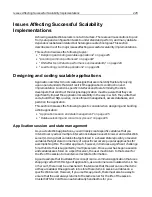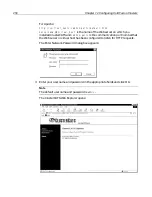
236
Chapter 11 Scalability and Availability Overview
submit or retrieve information from your database. Or, a mail server can go
down, making it impossible for your users to successfully send mail to you.
Ensure that your organization’s IT architecture includes network monitoring and
notification software that can quickly report on the general health of your
network and alert you about any failed servers.
A Web site availability scenario
Imagine that you’ve just built a robust, interactive e-commerce Web site on which
you plan to sell the most sought-after books and music in the world. You’ve used Java
scriptlets to build the application, so of course you’ve taken advantage of it’s many
built-in features, including secure database access, multi-threading, and integrated
session management.
Upon finishing the development work and quality assurance testing, you deploy the
Web site onto a single production Web server that is hosted within your IT
department. The IT department informs you that it is able to use its existing Internet
connection to make your site “live” while minimizing additional hosting support
costs by going to an outside vendor. The site goes live the following day and it’s an
instant success. Orders start pouring in the very first day, and huge numbers of
people log on to browse and buy. Everything seems perfect. Except, on the second
day of business, the load hitting the site is so high, the Web server’s performance
slows to a crawl, eventually causing the server to become unavailable. Suddenly, your
tech support lines are ringing off the hook with complaints that users cannot access
your site, causing you to miss out on tons of sales.
Although the application may have contained many useful features and capabilities,
the customers were not able to use them for very long because the site’s performance
degraded to the point that the site eventually became unavailable. Because the site
was deployed on only a single server, there was no way to load balance the incoming
traffic. Additionally, without multiple redundant servers in place, the site was not
capable of intelligently load balancing increasing traffic nor able to redirect traffic to
other available servers (no failover).
This simple scenario illustrates that a critical part of any successful Web
development effort must include adequate scalability, performance, and failover
planning. Servers can become overloaded or fail at any time for many reasons, so
make sure that your design, development, testing, and deployment strategies are
sound, promote good communication between necessary departments, and include
adequate disaster recovery capabilities.
Summary of Contents for COLDFUSION 5-ADVANCED ADMINISTRATION
Page 1: ...Macromedia Incorporated Advanced ColdFusion Administration ColdFusion 5...
Page 20: ......
Page 56: ...38 Chapter 1 Advanced Data Source Management...
Page 74: ...56 Chapter 2 Administrator Tools...
Page 76: ......
Page 86: ...68 Chapter 3 ColdFusion Security...
Page 87: ...To Learn More About Security 69...
Page 88: ...70 Chapter 3 ColdFusion Security...
Page 130: ...112 Chapter 5 Configuring Advanced Security...
Page 132: ......
Page 154: ...136 Chapter 6 Configuring Verity K2 Server...
Page 162: ...144 Chapter 7 Indexing XML Documents...
Page 202: ...184 Chapter 8 Verity Spider...
Page 236: ...218 Chapter 10 Verity Troubleshooting Utilities...
Page 238: ......
Page 348: ...330 Chapter 14 ClusterCATS Utilities...
Page 349: ...Using sniff 331...
Page 350: ...332 Chapter 14 ClusterCATS Utilities...
Page 362: ...344 Chapter 15 Optimizing ClusterCATS...
Page 372: ...354 Index...
















































